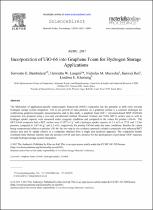JavaScript is disabled for your browser. Some features of this site may not work without it.
- ResearchSpace
- →
- Research Publications/Outputs
- →
- Journal Articles
- →
- View Item
| dc.contributor.author |
Bambalaza, Sonwabo E

|
|
| dc.contributor.author |
Langmi, Henrietta W

|
|
| dc.contributor.author |
Musyoka, Nicholas M

|
|
| dc.contributor.author |
Ren, Jianwei

|
|
| dc.contributor.author |
Khotseng, LE

|
|
| dc.date.accessioned | 2018-10-05T10:22:28Z | |
| dc.date.available | 2018-10-05T10:22:28Z | |
| dc.date.issued | 2018-05 | |
| dc.identifier.citation | Bambalaza, S.E. et al. 2018. Incorporation of UiO-66 into graphene foam for hydrogen storage applications. Materials Today: Proceedings, vol. 5(4): 10431-10439 | en_US |
| dc.identifier.issn | 2214-7853 | |
| dc.identifier.uri | https://www.sciencedirect.com/science/article/pii/S2214785317333254 | |
| dc.identifier.uri | https://doi.org/10.1016/j.matpr.2017.12.323 | |
| dc.identifier.uri | http://hdl.handle.net/10204/10439 | |
| dc.description | © 2017 The Author(s). This is an open access article under the CC BY-NC-ND license. | en_US |
| dc.description.abstract | The fabrication of application-specific metal-organic framework (MOF) composites has the potential to shift more towards hydrogen storage system integration. The in-situ growth of nano particles on a graphene surface is a common technique for synthesizing graphene-inorganic nanocomposites and in this study, a graphene foam (GF) / zirconium-based MOF (UiO-66) composite was prepared using a two-step solvothermal method. Brunauer, Emmett and Teller (BET) surface area as well as hydrogen uptake capacity were measured under cryogenic conditions and compared to the values for pristine UiO-66. The GF/UiO-66 composite had a BET surface area of 1073 m2.g-1 and a hydrogen uptake capacity of 1.1 wt% at 77 K and 1.2 bar pressure, compared to 1367 m2.g-1 and 1.5 wt%, respectively for pristine UiO-66 under the same conditions. Besides the values being compromised relative to pristine UiO-66, the two-step in-situ synthesis approach yielded a composite with enhanced BET surface area and H2 uptake relative to a composite obtained from a single step synthesis approach. The composites further exhibited better thermal stability than the pristine UiO-66 and show promise for the development of powdered MOF materials towards hydrogen storage system integration. | en_US |
| dc.language.iso | en | en_US |
| dc.publisher | Elsevier | en_US |
| dc.relation.ispartofseries | Worklist;21349 | |
| dc.relation.ispartofseries | Worklist;21430 | |
| dc.subject | Graphene foam | en_US |
| dc.subject | UiO-66 | en_US |
| dc.subject | Hydrogen uptake | en_US |
| dc.subject | Zr-MOF | en_US |
| dc.title | Incorporation of UiO-66 into graphene foam for hydrogen storage applications | en_US |
| dc.type | Article | en_US |
| dc.identifier.apacitation | Bambalaza, S. E., Langmi, H. W., Musyoka, N. M., Ren, J., & Khotseng, L. (2018). Incorporation of UiO-66 into graphene foam for hydrogen storage applications. http://hdl.handle.net/10204/10439 | en_ZA |
| dc.identifier.chicagocitation | Bambalaza, Sonwabo E, Henrietta W Langmi, Nicholas M Musyoka, Jianwei Ren, and LE Khotseng "Incorporation of UiO-66 into graphene foam for hydrogen storage applications." (2018) http://hdl.handle.net/10204/10439 | en_ZA |
| dc.identifier.vancouvercitation | Bambalaza SE, Langmi HW, Musyoka NM, Ren J, Khotseng L. Incorporation of UiO-66 into graphene foam for hydrogen storage applications. 2018; http://hdl.handle.net/10204/10439. | en_ZA |
| dc.identifier.ris | TY - Article AU - Bambalaza, Sonwabo E AU - Langmi, Henrietta W AU - Musyoka, Nicholas M AU - Ren, Jianwei AU - Khotseng, LE AB - The fabrication of application-specific metal-organic framework (MOF) composites has the potential to shift more towards hydrogen storage system integration. The in-situ growth of nano particles on a graphene surface is a common technique for synthesizing graphene-inorganic nanocomposites and in this study, a graphene foam (GF) / zirconium-based MOF (UiO-66) composite was prepared using a two-step solvothermal method. Brunauer, Emmett and Teller (BET) surface area as well as hydrogen uptake capacity were measured under cryogenic conditions and compared to the values for pristine UiO-66. The GF/UiO-66 composite had a BET surface area of 1073 m2.g-1 and a hydrogen uptake capacity of 1.1 wt% at 77 K and 1.2 bar pressure, compared to 1367 m2.g-1 and 1.5 wt%, respectively for pristine UiO-66 under the same conditions. Besides the values being compromised relative to pristine UiO-66, the two-step in-situ synthesis approach yielded a composite with enhanced BET surface area and H2 uptake relative to a composite obtained from a single step synthesis approach. The composites further exhibited better thermal stability than the pristine UiO-66 and show promise for the development of powdered MOF materials towards hydrogen storage system integration. DA - 2018-05 DB - ResearchSpace DP - CSIR KW - Graphene foam KW - UiO-66 KW - Hydrogen uptake KW - Zr-MOF LK - https://researchspace.csir.co.za PY - 2018 SM - 2214-7853 T1 - Incorporation of UiO-66 into graphene foam for hydrogen storage applications TI - Incorporation of UiO-66 into graphene foam for hydrogen storage applications UR - http://hdl.handle.net/10204/10439 ER - | en_ZA |






